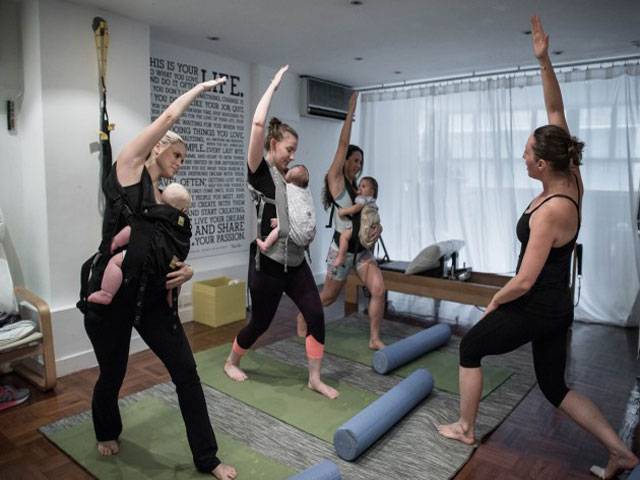AFP
HONG KONG
High up in one of Hong Kong’s ubiquitous skyscrapers a group of women are being put through their paces, straining against the weight of a novel training accessory - their children.
Dubbed ‘Mumba’ these exercise classes are a new twist on the baby-wearing trend gripping mothers in the city.
Once the preserve of traditional communities, the art of wrapping a baby across a caregiver’s body so it can be carried during daily activities is being taken up by modern parents. In Hong Kong, where narrow hilly streets and unforgiving urban landscape often render strollers and prams useless — many frustrated parents are now going back to basics out of necessity. Proving the old adage, invention has followed. ‘Mumba’ fitness, baby-wearing bellydance, ballet, yoga and pilates classes, and even suspension training (TRX) classes have sprung up in recent months - all allowing parents to exercise while their baby is strapped to them in a carrier. “There is huge demand from mums who wanted to get back in shape and to get strong again after the challenges of labour, but who also didn’t want to leave their young babies behind while they spent time exercising,” explains Ifat Hindes, co-founder of Mumba Fitness.
“We have combined different types of exercise including yoga, dance, TRX, and pilates, and the bonus is that you are using your baby for weight training,” she says. “There’s no need for expensive gadgets — it’s just you and your baby, with other parents, being guided by a professional. You know everyone is in the same boat. Hong Kong can be a difficult and unwelcoming city for new mothers.”
While in many cities frazzled parents can soothe their baby - and stretch their legs - by strolling through the park with the pram, Hong Kong’s high-rise living and unwieldy streets can leave many here feeling trapped and lonely in relatively small apartments.
New mother Angela Gou explains: “I was looking for a way to get out and meet other mums. I always want to exercise but it’s hard to leave the baby at home. So these sessions solve the problem. Plus my baby likes it and thinks we’re playing a game.”
Most baby-wearing exercise programmes recommend infants are three months or older to take part to ensure adequate neck control, and check positioning to ensure babies hips are protected. Chartered physiotherapist Helen Binge, who runs paediatric firm Physiobaby, told AFP: “The growing trend to exercise whilst baby-wearing is fine, as long as the baby sling is very supportive, and the activity level of the baby wearer is not too vigorous.”
From structured types for sport to traditional woven cloth style, there is now a baby-wearing option for every occasion. “Carriers have been used across cultures for thousands of years, but, like breastfeeding, went out of ‘vogue’ for a long period as people moved toward a more product-driven approach toward caring for small babies,” says Trish Kelly who co-founded Hong Kong’s Babywearing group.
She adds that renewed interest in natural birth and breastfeeding has meant traditional approaches to child-rearing are back in fashion. “But for Hong Kong I think it comes down to practicality. Moms like what works. Baby-wearing is a practical way of getting around. It is notoriously wheelchair and stroller unfriendly — I feel like every ramp has a set of stairs at the end.”
Friday, April 19, 2024
Baby-wearing revival gets a fitness twist in Hong Kong

3:56 PM | March 28, 2024
4:14 PM | March 23, 2024
Mehwish Hayat says she would like to work with Aamir Khan
9:59 PM | April 18, 2024
'That'll be awesome,' Rohit Sharma on idea of Pakistan vs India Test series
9:17 PM | April 18, 2024
Turkiye commends Pakistan's efforts in fostering regional peace
9:03 PM | April 18, 2024
CM Maryam's security squad hits biker to death in Narowal
9:02 PM | April 18, 2024
Hafiz Naeemur Rehman sworn in as new emir of Jamaat-e-Islami
8:54 PM | April 18, 2024
Hepatitis Challenge
April 18, 2024
IMF Predictions
April 18, 2024
Wheat War
April 18, 2024
Rail Revival
April 17, 2024
Addressing Climate Change
April 17, 2024
Justice denied
April 18, 2024
AI dilemmas unveiled
April 18, 2024
Tax tangle
April 18, 2024
Workforce inequality
April 17, 2024
New partnerships
April 17, 2024
ePaper - Nawaiwaqt
Advertisement
Nawaiwaqt Group | Copyright © 2024





